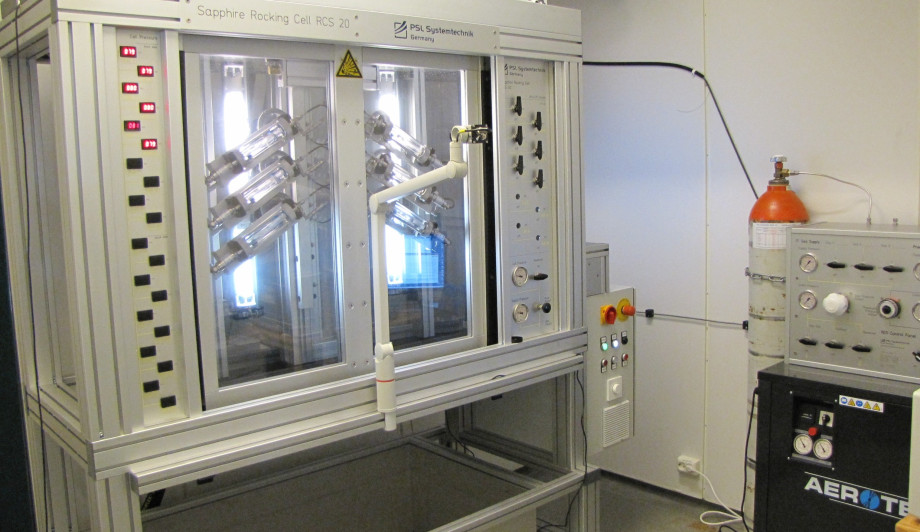Eco Inhibitors, a spin-off from the University of Stavanger, has brought breakthroughs to the oil and gas industry with its eco-friendly hydrate inhibitors. Under the leadership of Professor Malcolm Kelland and support from Validé (the innovation company of UiS), the research transitioned from labs to commercial success, culminating in the acquisition by Italmatch Chemicals. This case study highlights the significant environmental and economic impacts of this innovation, showcasing the pathway from fundamental research to market-ready solutions.

High-pressure sapphire rocking cell gas hydrate inhibitor test equipment
Hydrate inhibitors are chemicals which are used to counteract the formation of gas hydrate (an ice-like substance stable under pressure) in pipes carrying oil and gas. The chemicals that Kelland and his team developed throughout the years are better for the environment and employees' health than the antifreeze fluids methanol and glycol, which have previously been commonly used in the oil industry.
Underpinning research
The underpinning research for Eco Inhibitors’ hydrate inhibitors involved a combination of fundamental research, industry collaboration, and rigorous testing. The journey began in the early 1990s when Professor Malcolm Kelland joined RF-Rogaland Research (now NORCE). The initial focus was on developing low-dosage hydrate inhibitors (LDHIs) to prevent hydrate formation in oil and gas pipelines. Hydrates can form under high pressure and low temperatures, causing blockages that are hazardous and costly to remove.
The early research, sponsored by ExxonMobil, led to the development of kinetic hydrate inhibitors (KHIs) and anti-agglomerants (AAs). KHIs delay hydrate formation, while AAs allow hydrates to form but prevent them from aggregating into blockages. Despite initial progress, the industry-standard AAs were not environmentally friendly, prompting further research into green alternatives. In the mid-1990s, a consortium led by Kelland and funded by multiple oil companies and the Norwegian Research Council (NFR) aimed to develop biodegradable AAs. Although initial attempts were not green enough, the research laid the groundwork for future innovations.
After moving to the University of Stavanger in 2001, Kelland continued this work at the research group of Green and sustainable chemistry, focusing on green KHIs and AAs. This period saw significant advancements, including the development of a novel AA which was both effective and biodegradable.
Key publications during this period include:
- Li et al. (2017): This study reported on the environmental testing and performance of the new AA. The AA showed ready biodegradability in seawater and low potential for bioaccumulation, making it environmentally acceptable for the Norwegian continental shelf [1].
- Magnusson et al. (2018): This paper detailed the development of a KHI based on fish waste. The optimal product, KHI530, was determined using KHI screening tests by the slow constant cooling method in multiple rocking cells. The performance was better than a low molecular weight poly(N-vinylpyrrolidone) for a synthetic natural gas mixture forming primarily structure II hydrate and about the same performance for structure I methane hydrate [2].
The green KHIs research led to two patents, including the fish waste technology. The green AA research was also successful, building on the work from the 1995-2000 consortium. The chemistry was adjusted to improve performance and biodegradability, leading to further patents and publications [3, 4].
Key Research Findings can be summarized as below:
KHI530 Development: The KHI530 product was developed based on a cheap, abundantly available natural product that is readily biodegradable and low in toxicity. It was tested for its ability to prevent structure II natural gas hydrate formation in steel and sapphire rocking cells. The product showed no cloud point up to 95°C in deionized water or NaCl brines up to 7 wt%.
Environmental Testing: The new AA chemical developed in collaboration with Equinor and the University of Stavanger showed ready biodegradability in seawater and low potential for bioaccumulation. The AA chemical can be classified as environmentally acceptable for the Norwegian continental shelf according to the regulations of the Climate and Pollution Agency in Norway.
Performance in Field Conditions: The AA product was tested in various conditions, including dynamic cooling tests and shut-in/start-up tests in a flow simulator. The results indicated that the new AA performed well at about 13°C subcooling for the tested fluid system during shut-in/start-ups.
References to the research
[1] Xiaoyun Li, Ø. A. et al (26-29th March 2017). Discovery of an environmentally friendly low dosage hydrate inhibitor anti-agglomerant for NCS. Proceedings of the Oil Field Chemistry Symposium. Geilo, Norway.
[2] Carlos Magnusson, E. A. (2018). As Green As It Gets: An Abundant Kinetic Hydrate Inhibitor from. Energy & Fuels, 5, ss. 5772-5778. doi:10.1021/acs.energyfuels.8b00367
[3] Kelland, M. A. (2011). WIPO (PCT) Patentnr. WO2013053766A1.
[4] Kelland, M. A. (2017). Norway Patentnr. NO20191199A1.
Details of the impact
Environmental Impact
A major advantage of eco-inhibitors are their significant reduction of environmental impact through the use of biodegradable, non-toxic materials. Traditional gas hydrate inhibitors, like methanol and glycol, are widely used to prevent blockages in pipelines, but they have adverse effects on the environment and human health. Eco-inhibitors, in contrast, utilize natural, biodegradable materials, including natural fatty acids and fish waste, such as salmon by-products. These green inhibitors are designed to break down into non-toxic by-products, ensuring minimal environmental impact and a lower risk of bioaccumulation in marine ecosystems.
Through extensive laboratory and field testing, eco-inhibitors has proven that they meet stringent ecological requirements, including those specific to the Norwegian continental shelf, where environmental standards are notably high. These products are compatible with both regulatory requirements and corporate sustainability goals, making them an ideal choice for companies that operate in sensitive environmental regions. This adaptability allows oil and gas companies to pursue eco-friendly operations without compromising on safety or performance standards, ultimately contributing to a more sustainable industry.
By reducing carbon output, eco-inhibitors enhance the sustainability profile of the companies using them [B]. This technology directly supports global efforts to lower the environmental impact of energy production, especially in offshore oil and gas fields where stringent environmental standards exist. In this way, eco-inhibitors contribute to a lasting positive impact on the environment, promoting sustainable practices across a traditionally high-emission sector.
Cost-Effectiveness and Enhanced Operational Efficiency
Eco-inhibitors present significant economic benefits, largely due to its low dosage requirements and effective performance in preventing hydrate formation at low temperatures. Traditional inhibitors are costly to deploy and maintain, but the cost-effective nature of eco-inhibitors allows companies to reduce their expenses over time. With these eco-friendly inhibitors, fewer interventions are necessary to maintain flow in pipelines, which ensures uninterrupted operations with reduced maintenance demands. This advantage lowers both direct costs and the operational challenges associated with hydrate formation, making eco-inhibitors financially attractive choice for companies that are transitioning to greener solutions. Fields developments can also be designed from day 1 with the new technology, affording significant capital cost savings.
The impact of eco-inhibitors on operational efficiency is substantial. By preventing costly production halts, eco-inhibitors enable companies to maintain steady pipeline operations without relying on additional chemical additives or extensive infrastructure changes. The efficient performance of these inhibitors in challenging conditions means that companies can maintain smooth operations with less disruption, improving their bottom line while also reducing the resources required for frequent pipeline maintenance. As stated by Italmatch, the purchaser of Eco Inhibitors technology: “… we have had a successful commercial application in Canada, where the product performed very well and made a customer happy. We are working on a big case for Norway, and customer may need to finally approve the product in a pilot test” [C].
Enhanced Regulatory Compliance and Reputation
Eco-inhibitors are especially valuable for companies navigating strict environmental regulations. By meeting certification standards from CEFAS (Centre for Environment, Fisheries and Aquaculture Science, an executive agency of the United Kingdom government Department for Environment, Food and Rural Affairs) and PLONOR (materials which are considered to pose little or no risk to the environment, according to the OSPAR mechanism), eco-inhibitors ensure compliance with offshore chemical use regulations, helping companies avoid penalties and demonstrate responsible practices to stakeholders. As regulatory pressures increase globally, eco-inhibitors’ low environmental impact and biodegradability have become strategic advantages for oil and gas operators. Companies that adopt eco-inhibitors improve their reputations, aligning their operations with market demands for environmentally conscious practices [A]. In an era when investors and stakeholders prioritize sustainability, the use of certified green inhibitors bolsters a company’s standing as an industry leader in responsible production. By offering a compliant, eco-friendly solution, eco-inhibitors help companies strengthen their market position while meeting or exceeding regulatory standards.
Sources to corroborate the impact
[A] Italmatch Sustainability Report 2023
[B] Press release regarding acquisition of Eco Inhibitors by Italmatch Chemicals Group
[C] Global Marketing Director, Oil & Gas, Italmatch Chemicals
Contact
Department of Chemistry, Bioscience and Environmental Engineering
Department of Innovation and External Collaboration

